
- 208 pages
- English
- ePUB (mobile friendly)
- Available on iOS & Android
eBook - ePub
Festiniog Railway: The Spooner Era and After, 1830–1920
About this book
Festiniog Railway 1836–2014 describes the history of the worlds first steam-operated narrow gauge railway to carry passengers. It covers the history of the railway from its beginnings as a horse-worked tramroad in 1836, through its technical developments with the introduction of steam locomotives, Fairlie articulated locomotives and bogie carriages through its twentieth-century decline, to closure in 1946, and then to the preservation era and its development as a major twenty-first-century tourist attraction.Built to serve the extensive slate industry in the Ffestiniog area of North Wales by carrying slate from the quarries to the port at Porthmadog, from 1865 the railway also operated a passenger service to serve the local community, which also attracted tourists. Closed in 1946 the railway was revived in stages from 1955, when a prolonged compensation claim was mounted against a major state-owned company for land taken to build a power station. Volunteers from all over the world came together to restore and operate this important piece of world industrial heritage, including the construction of the 2 mile deviation needed to bypass the power station. Services were resumed between Porthmadog and Blaenau Ffestiniog in 1982.The Festiniog Railway runs through some of the most beautiful countryside in North Wales, with spectacular views of mountains and lakes. The railway also has a very impressive collection of modern and historic motive power and rolling stock. It is one of the most successful tourist attractions in Wales and is one of the most important industrial history sites in the world.
Frequently asked questions
Yes, you can cancel anytime from the Subscription tab in your account settings on the Perlego website. Your subscription will stay active until the end of your current billing period. Learn how to cancel your subscription.
At the moment all of our mobile-responsive ePub books are available to download via the app. Most of our PDFs are also available to download and we're working on making the final remaining ones downloadable now. Learn more here.
Perlego offers two plans: Essential and Complete
- Essential is ideal for learners and professionals who enjoy exploring a wide range of subjects. Access the Essential Library with 800,000+ trusted titles and best-sellers across business, personal growth, and the humanities. Includes unlimited reading time and Standard Read Aloud voice.
- Complete: Perfect for advanced learners and researchers needing full, unrestricted access. Unlock 1.4M+ books across hundreds of subjects, including academic and specialized titles. The Complete Plan also includes advanced features like Premium Read Aloud and Research Assistant.
We are an online textbook subscription service, where you can get access to an entire online library for less than the price of a single book per month. With over 1 million books across 1000+ topics, we’ve got you covered! Learn more here.
Look out for the read-aloud symbol on your next book to see if you can listen to it. The read-aloud tool reads text aloud for you, highlighting the text as it is being read. You can pause it, speed it up and slow it down. Learn more here.
Yes! You can use the Perlego app on both iOS or Android devices to read anytime, anywhere — even offline. Perfect for commutes or when you’re on the go.
Please note we cannot support devices running on iOS 13 and Android 7 or earlier. Learn more about using the app.
Please note we cannot support devices running on iOS 13 and Android 7 or earlier. Learn more about using the app.
Yes, you can access Festiniog Railway: The Spooner Era and After, 1830–1920 by Peter Johnson in PDF and/or ePUB format, as well as other popular books in Technology & Engineering & Rail Transportation. We have over one million books available in our catalogue for you to explore.
Information
CHAPTER 1
1825-1836 ORIGINS AND CONSTRUCTION
The estuaries of the Dwyryd and Glaslyn rivers meet the sea together in the north-east corner of Cardigan Bay, close by the borders of Merionethshire and Caernarfonshire, their Welsh names, respectively Traeth Bach and Traeth Mawr, describing their appearance, small and large beach, or perhaps more poetically, small and large sands. Both rivers played their part in the development of the Ffestiniog slate industry and the Festiniog Railway.
The Dwyryd, in the nineteenth century, was navigable close to Maentwrog. Several wharves were used to tranship slate carried down from the quarries on pack animals and carts, small boats carrying it out to deeper water at Ynys Cyngar, on the Caernarfonshire coast beyond Borth y Gest, a port barely worthy of the word developed by William Alexander Madocks, a local landowner and the MP for Boston, Lincolnshire. There it was transhipped again, into coastal craft.
The Glaslyn was much wider, more than a mile across in parts, navigable nearly to the pass at Aberglaslyn, dotted with small islands and overlooked by high cliffs on its northern bank. At low tide, hundreds of acres of sand were exposed, crossable with care but otherwise enforcing a long detour on travellers. Madocks, the owner of the Tan yr Allt estate, having already constructed an embankment (cob in Welsh) to reclaim the estuarial land where he developed Tre Madoc, later Tremadoc and now Tremadog, and on which Portmadoc was later developed, determined on a much larger reclamation by building an embankment across the narrowest part, between Ynys y Tywyn and the Merionethshire shore, nearly a mile. Obtaining powers in 1807, the work was completed in 1811, reclaiming around 3,000 acres.
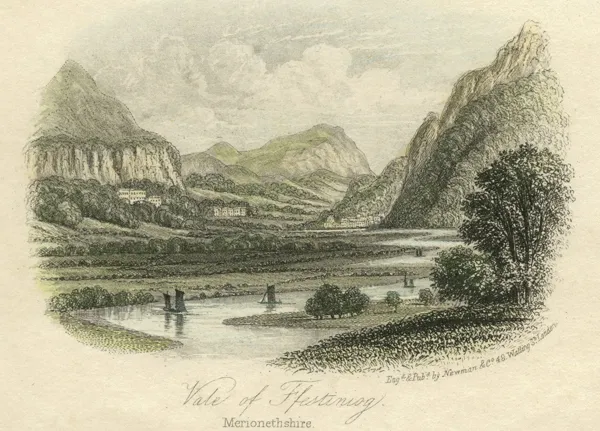
The Afon Dwyryd near Maentwrog, the route for slate before the Festiniog Railway. (Newman & Co)
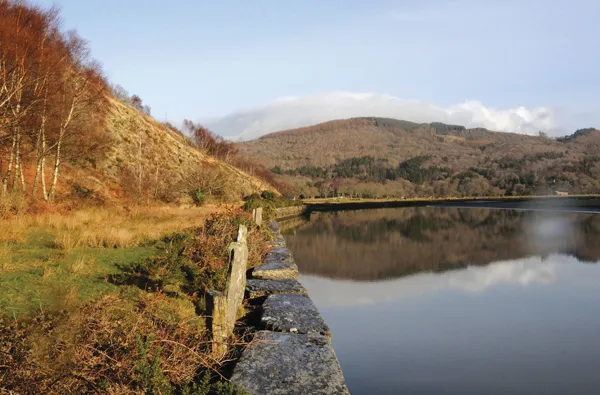
Tyddyn Isa wharf on the Dwyryd, completed in 1824 and out of use some 20 years later, is the largest of the wharves along the river. (Author)
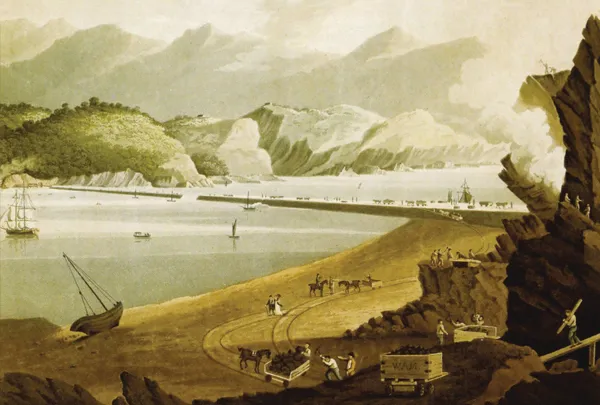
The construction of Madocks’ embankment seen from Ynys y Tywyn, 1810. (H. W. Billington)

A plan of the area around Ynys y Tywyn, signed by Madocks’ agent, John Williams on 8 July 1833. The passenger terminal of the Festiniog Railway was to be built close to the spot marked C. (FR Archives)
Quarried since ancient times, demand for the Ffestiniog area’s high-quality Ordovician slate was boosted by the roofing requirements generated by the industrial revolution. As a result, the area became one of the great Welsh slate quarrying centres, the present town of Blaenau Ffestiniog developing to serve it.
Three quarries were working commercially by 1825, shipping around 11,000 tons annually between them. The transport was primitive, hampered by the slate’s location, 1,000ft above sea level and some 14 miles from the sea. This meant that within 20 miles, it was transhipped three times, increasing its cost and the risk of damage. There had been some improvement from 1824, when the last transfer was moved to the new harbour, Port Madoc. In constructing his embankment, Madocks had diverted the Glaslyn through a channel between Ynys y Tywyn and the Caernarfonshire shore, unwittingly creating a location suitable for a harbour when the river scoured out the sand.
An Act of Parliament in 1821 had given Madocks powers to improve and manage the harbour, requiring anyone building a railway from the quarries to the Merionethshire end of the embankment ‘to use the Railway now or hereafter lying upon and along the said Embankment, and from thence to the said intended Quay or Port …’
Railways used during the embankment’s construction had been removed on its completion in 1811 but that on the embankment had been reinstated when it was breached in 1812. The gauge is not known for sure but was probably 3ft 6in.
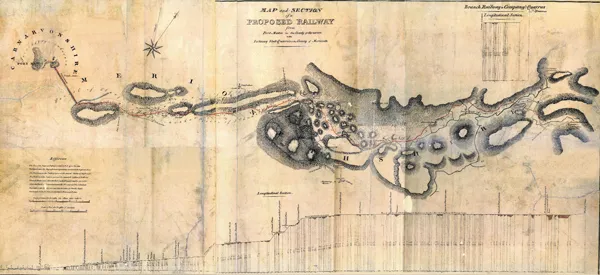
W. A. Provis's survey of 1824-5. (FR Archives)
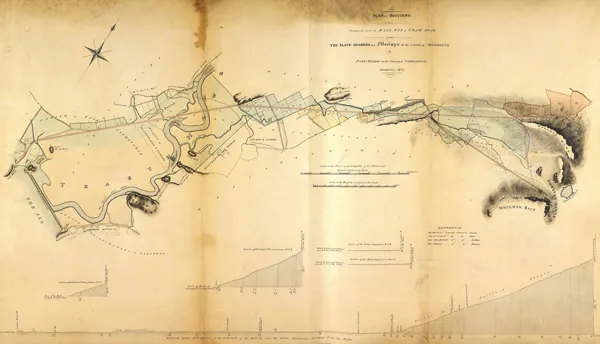
James Spooner’s 1825 survey for a railway from quarries on the Moelwyns to Port Madoc. (Parliamentary Archives)

Spooner’s 1831 plan for the Festiniog Railway. (Parliamentary Archives)
With the quarries located at around 1,000ft above sea level, there was no obvious route for a railway. On 8 November 1824, Madocks gave notice of his intention to apply for powers to build the Festiniog Railway from locations 300ft below the slate quarries to the east end of the embankment. Surveyed by George Overton and J. Bourn, the route used three inclines to land just above sea level at Dol y Moch, near Maentwrog, following the Dwyryd thence to Minffordd, where it crossed into the Glaslyn valley to reach the embankment.
On the same date, notice was also given of the intention to seek powers for the Festiniog & Port Madoc Railway, a line from Maenyfferam farm, near Duffws, to the port. This took a high-level alignment to Creuau farm before falling to 225ft at Rhiw Goch via four inclines; from Rhiw Goch the proposed route was similar to that of the Festiniog Railway as built. This route was surveyed by William Alexander Provis, resident engineer on Telford’s Menai bridge. The identity of the promoters is unknown. It may be significant that the solicitor signing the notice also worked for William Gruffydd Oakeley, who owned some of the land being quarried.
Petitions for both railways were presented to the House of Commons in March 1825 and their Bills referred to committees. Both failed to comply with standing orders. Madocks not having the resources to continue, in October the Festiniog & Port Madoc Railway notice was reissued. On 19 October 1825, a notice of intent was also issued for the Moelwyn & Port Madoc Railway, not too dissimilar to the later Croesor Railway, to serve quarries under development in the Croesor valley; it had been surveyed by James Spooner although the estimate for £20,008 16s 8d was signed by a Richard Smith.
After much wrangling between the parties, the Festiniog Bill was withdrawn, despite the Moelwyn scheme being of no value to the Festiniog quarries. The Moelwyn Bill, however, failed with the dissolution of Parliament in 1826 and its promoters withdrew from slate quarrying.
A depression in the slate trade, which was in any event further restricted by the duty imposed on slate shipped coastally, as in the Festiniog case, was responsible for the loss of interest in building a railway. Nothing more happened until after Madocks’ death in 1828, although that was not relevant to the circumstances surrounding the development of the Festiniog Railway. The high cost of transporting the slate from the quarry to the sea, 13s 3d per ton, almost double the cost of production, provided the incentive for promoting a railway as costs and breakages would almost certainly be reduced.
Towards the end of 1829, one of the Ffestiniog quarry proprietors, Samuel Holland Junior, met Dubliner Henry Archer on several occasions in the parlour of The Stag at Pen y Groes; we have Holland to thank for this level of detail as years later he wrote his memoirs. Holland’s quarry was at Rhiwbryfdir, to the north of the later town. His father had leased the land from Oakeley in 1821; the rights to part of it were sold to the Welsh Slate Company in 1825.

Most Ffestiniog slate was quarried from underground chambers, which explains the lack of contemporary illustrations to represent the development of the activity. Following a number of rock falls, the Welsh Slate Company’s quarry at Rhiwbryfdir was the exception, with some quarrying carried on in the open. The WSC incorporated the quarry worked by the railway’s first customer, Samuel Holland.
On one occasion Archer mentioned to Holland that he was thinking of leasing the Nantlle Railway, the 3ft 6in gauge horse tramway that linked the Nantlle slate quarries with Caernarvon that had been opened in 1828. Holland replied that he should visit Ffestiniog and plan a railway between the quarries there and Port Madoc.
Soon after, Archer went over the ground and declared that he was prepared to take on the task, Holland encouraging him to employ James Spooner to make a survey. Born in Worcestershire, employment with the Ordnance Survey had taken Spooner to Wales, where he settled, for a time leasing Madocks’ house at Tremadoc. Holland does not explain how they met but, giving evidence in a trespass dispute in 1833, Spooner said that he had been to Rhiwbryfdir to survey some land in 1828 and that Holland might have been there.
Spooner, aided by his third son, Charles Easton, made a survey and a Bill was deposited in Parliament in the first months of 1831. The route was to start ‘at or near the quay at Port Madoc’, cross the Traeth Mawr embankment and terminate ‘at or near’ the Rhiwbryfdir and Duffws slate quarries, described this way despite the expectation that the main traffic flow would be in the opposite direction. The survey was masterly, with an even gradient from Boston Lodge to the proposed termini.
The Bill failed due to a clerical error, the omission of the words ‘heirs and assigns’ in the clause protecting the rights of Madocks’ heirs, but there were objections too, from quarry owners, land owners, carters, boatmen and Madocks’ heir amongst others. The North Wales Chronicle’s 26 April report said that the opposition was trivial, one of the objectors complaining that Spooner was disqualified from making the survey because he worked for the Crown.
In the meantime, on 17 December a group of slate quarry owners and traders had met in Caernarfon to agree to petition for the repeal of the slate duty. There was no duty on slate imported to England from Ireland and a change in the rules had had the effect of removing it from English slate but Welsh slate shipped coastally attracted duty in the range of 25-75 per cent. Archer was amongst those present, afterwards subscribing £10 on behalf of the ‘Ffestiniog Railroad Company’. Madog ap Owain Gwynedd, in his monograph submitted to the literary competition at the 1856 Portmadoc Eisteddfod, wrote that the incentive for the campaign on slate duty came from hearing that it was to be removed from coal. The duties were withdrawn by an Act enacted on 23 August 1831 and backdated to 1 March. This development enabled the Welsh slate quarries to be expanded and, ultimately, the Festiniog Railway to be successful.
In February 1831, Archer and ten members of Dublin society agreed to commit £23,000 to the construction of the Festiniog Railway; an undated copy of the contract is preserved in the Parliamentary Archives. With £8,000, Archer promised the largest share, followed by James Smith (£5,600), William Read (£5,000) and Edward Keane (£3,700); Richard Smyth, George Archer, George Studdart, Stephen Woulfe, Arthur Perrin, John Foster and John Cummins committed £100 each. A second notice was published on 12 September.
This time there was no opposition to speak of and the Act received the royal assent on 23 May 1832. It contained 152 clauses and a schedule, requiring seventy foolscap pages on a contemporary printed copy. The company was empowered to make a railway, ‘The Festiniog Railway’, nearly 14 miles long to be passable for wagons and other carriages. Of the would-be proprietors named in the share contract, Messrs Read, Keane and Foster were not named in the Act but a Daniel Smyth was. There were many aspects covered by the Act. The route could not deviate more than 100yd from the plan, with no deviation at all allowed through Oakeley’s estate; walls up to 10ft high would have to be built there and the line was not to pass closer than 82yd to Plas Tan y Bwlch. The normal width of the formation was to be four yards except at crossing places, wharves, warehouses and cranes, and at the sites of embankments or cuttings where it was to be no more than 60yd without the consent of the owners of the adjoining land. No more space than was absolutely necessary was taken over the Traeth Mawr embankment where the line was to be laid on the west side of the existing road. Here the rails were to be no more than 3ft apart, the only reference to gauge in the Act.
The company could not charge more than 6½d per ton per mile for the carriage of slate. For other minerals, timber, grain and merchandise the maximum rate was set at 7½d. Suitably inscribed ‘stones or other conspicuous marks’ were to be set up ‘and for ever maintained’ at quarter mile intervals. William John Bankes, Dol y Moch, and his tenants were to be charged a moiety (half) of the rates for any lime, limestone, dung, compost or manure carried by or for them.
The owners of wagons or carriages passing along the railway were to provide written details of the source and destination of their loads, along with details of their contents. For the purpose of the act, 112lb was specified as 1cwt and 20cwt as 1 ton of slate, tiles, copper and other ores and other articles. 14cu ft of stone, 40cu ft of oak, mahogany, beech and ...
Table of contents
- Cover
- Title
- Copyright
- CONTENTS
- Acknowledgements and sources
- Place names, Currency and the value of money
- Introduction
- 1 1825-1836 Origins and construction
- 2 1836-1868 From horses to steam and passengers
- 3 1869-1889 Innovation, fame and competition
- 4 1889-1899 Fading glory
- 5 1900-1914 A brief recovery on the road to war
- 6 1914-1920 Government control
- APPENDIX 1 Operating expenses and revenue 1856-1875
- APPENDIX 2 Summary of results 1869-1920
- APPENDIX 3 Capital expenditure 1865-1929
- APPENDIX 4 Locations along the route – Ordnance Survey
- APPENDIX 5 Locations along the route – 1869
- BIBLIOGRAPHY